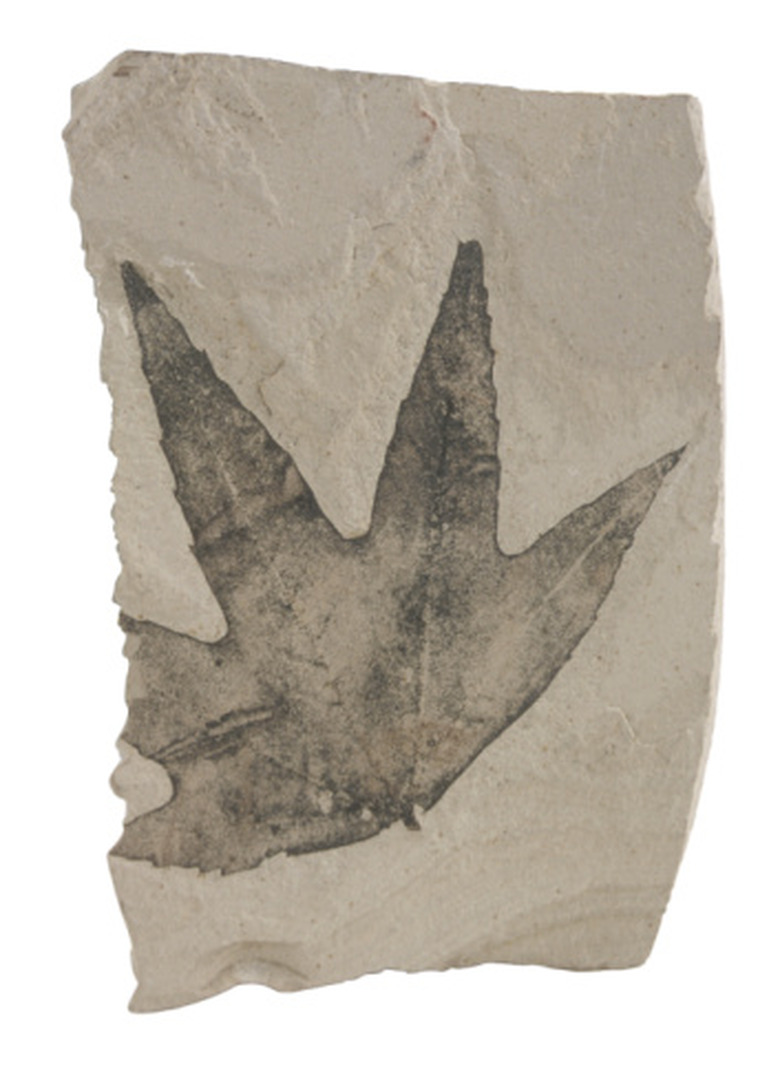What Are Carbon Film Fossils?
Fossils are the remains or traces of organisms that lived long ago and have been preserved. One fascinating and often beautiful kind of fossil is a carbon film fossil, or carbonized or compression fossil, that preserves an organism's remains in a two-dimensional pattern.
TL;DR (Too Long; Didn't Read)
Carbon film fossils are carbonized two-dimensional remains of organisms that were exposed to great pressure over long periods of time. Carbon film fossils can often preserve information about the original organism's shape, features and evolutionary placement.
Fossils and Their Importance
Fossils and Their Importance
Both paleontologists and geologists use fossils to help determine what life and geology were like in the distant past. Through the remains of plants and animals from long ago, a picture of life at that time emerges. The fossilized organism might retain features such as leaves, stems, bones, teeth or other remains that can help categorize it and its family tree.
Geologists benefit from fossil discoveries by being able to use them for dating the rocks around them. Paleobotanists have learned about ancient forests that no longer exist in many parts of the world from the evidence that carbon film fossils, in particular, have left behind in coal deposits.
Kinds of Fossils
Kinds of Fossils
Many kinds of fossils form, depending on what occurred after an organism died and what environment they were in. Different types of fossils include mold and cast fossils, permineralization or petrified fossils, replacement or recrystallization fossils, compression or carbon film fossils, trace fossils and frozen fossils.
A dead organism's shape is retained as sediment fills in its cavities for mold and cast fossils. Permineralization fossils form when minerals seep into spaces in the organism, making a sort of internal cast and petrifying it (turning it to stone). This process often occurs with wood (hence, petrified wood) or bone. Replacement occurs when all organic material in the organism is replaced by other minerals; this is sometimes called recrystallization.
Trace fossils contain no part of the original organism but rather a trace of it, such as a footprint in sediment. Burrows are also preserved in this manner; these trace fossils provide useful information about where organisms lived and the size of their body parts, such as feet. Frozen fossils are those organisms that are completely encased in ice, such as mammoths; often, such fossils preserve internal organs, which would not be possible in other forms of fossilization.
Carbon film fossils, also called compression or carbonization fossils, represent another fossil that gives valuable information. So, what exactly are these fossils, and how were they formed?
Carbon Film Fossils or Compression/Carbonized Fossils
Carbon Film Fossils or Compression/Carbonized Fossils
Carbon film fossils are also called compression fossils or carbonized fossils. Carbonized fossils can often be found near coal seams. The term carbonization refers to the process of something being changed into carbon.
The remains of an organism were exposed to tremendous pressure over time, such as being buried under sediments beneath a seafloor. This process is called compression, which, in addition to pressing something together, also means its size and volume are reduced. Once the remains are pressed, eventually, many of its components are siphoned away, such as hydrogen, nitrogen and oxygen. This leaves a carbon film or residue behind in a thin layer on a rock that is two-dimensional.
A carbon film imprint of an organism in flattened form remains with carbon film fossils, yet many features of that original organism can be seen on this form of fossil. For example, researchers can easily discern the stems and leaves of plants and even glean cellular information from the fossils.
While it is not uncommon to find plant fossil films, it is less common to find animal remains that are as well preserved in this fashion. Typically, these are invertebrate animals like insects. Recently, scientists discovered a carbon film fossil of an arthropod brain from over 500 million years ago in China. Scientists used the two-dimensional brain remains to help classify the arthropod into an appropriate evolutionary branch.
With carbon film fossils, scientists have a "snapshot" of life from ancient times. With this, they can help you understand how life on Earth changed over time and how the Earth itself has changed. This aids in understanding humanity's own roles and interactions on Earth today.
References
- University of California Berkeley Museum of Paleontology: Fossils – Window to the Past
- National Park Service: Florissant Fossil Beds: Make Your Own Fossils
- University of Colorado Boulder Museum of Natural History: Fossil Preservation
- The Brain Preservation Foundation: Carbon Film Preservation of an Arthropod Fossil Brain From 500 Million Years Ago
- British Geological Survey: Discovering Geology – Fossils and Geological Time
Cite This Article
MLA
Hermance, Dianne. "What Are Carbon Film Fossils?" sciencing.com, https://www.sciencing.com/carbon-fossils-8143044/. 2 November 2021.
APA
Hermance, Dianne. (2021, November 2). What Are Carbon Film Fossils?. sciencing.com. Retrieved from https://www.sciencing.com/carbon-fossils-8143044/
Chicago
Hermance, Dianne. What Are Carbon Film Fossils? last modified August 30, 2022. https://www.sciencing.com/carbon-fossils-8143044/
